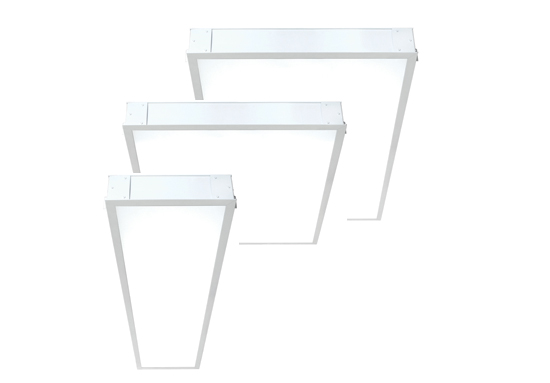LED Lighting for Commercial Ceilings
LED Panel Luminaire Attributes
As we have seen, LED luminaires use electronic light-emitting diodes to produce light very efficiently. In fact, they could well be the most efficient and cost-effective choice for many commercial buildings. One type in particular, an LED panel luminaire is a complete solution that provides both appropriately ample light quantity and excellent light quality as well. Some of the attributes of this type of luminaire are as follows.
Physical Attributes
An LED panel fixture is fundamentally different than a fluorescent troffer fixture. Instead of separate housings, lamps and diffusers, the LED panel is a complete, one-piece box style enclosed product. To provide the greatest flexibility, LED panel luminaires are manufactured to be installed into suspended ceilings as drop in troffer style fixtures. Through the use of trim kits, they can also be flush mounted to gypsum board or plaster ceilings. As such, they can be easily incorporated into new or existing ceiling designs with relative ease.
LED panels are commonly shaped to match industry standard commercial fluorescent luminaire sizes including 2x4, 2x2, and 1x4 with a nominal depth of only 3 inches. The driver is located outside of the main optical chamber of the panel for cooler operation and service access when required. This driver location has minimal impact to fixture depth. For luminaires that need to serve as emergency lighting, a battery backup can be fitted to match the depth of the driver in some cases and maintain clearance around the panel fixture.
In terms of operation, LED panel fixtures exhibit all of the desirable attributes of LED lamps. The light appears instantly without any waiting or delay when the luminaire is switched on. They are completely dimmable using approved, tested dimmers and dimming drivers designed for LED use. In these cases, they have been found to perform without any flickering that sometimes occurs with dimmed fluorescent lamps. They can also be step dimmed to customize light output as needed. There is also the possibility of zone control and integration into a Building Management System (BMS) to address variable use conditions, energy consumption control, and daylight integration so as to maintain light quality for the building space.
 |
LED panel luminaires are available in a range of industry standard sizes for commercial ceilings including 1x4, 2x2, and 2x4. Image courtesy of RAB Lighting, Inc. |
One other significant physical attribute is the fact that LED panels do not exhibit the temperature sensitivity that fluorescent luminaires can, particularly in colder settings. This makes them equally well suited for unheated parking garages and industrial settings as for offices and other temperature controlled commercial spaces.
Longevity Attributes
The long life of LED lamps applies to LED panel luminaires as well. An average rated life projection of between 50,000 and 100,000 hours to the L70 point means that LED panels could be installed once and not need to be replaced for decades. Key to this longevity is the fact that the electronic make-up of the LEDs allows the lumen output to remain constant over time, only decreasing slightly towards the end of its rated lifetime. Once its service time is complete, the luminaire can be removed and recycled then replaced with a new one at that time.
Light Quality Attributes
First and foremost, LED panel luminaires can now be manufactured to produce excellent color quality. Just as significantly, the shade of white light appears clear and consistent over time, unlike HIDs or other lamps that can change in color. And adding a dimmer doesn't detract from the quality since dimming LED panels can provide uniform appearance without changing color.
In order to produce this high level of color consistency, LED manufacturers have developed a systematic manner to address the normal variations inherent in any manufactured products. As LEDs are produced they are evaluated and sorted for variations in brightness (lumens). Then, using a sophisticated tool known as the four-step MacAdam ellipse the LEDs are evaluated for their specific color or chromaticity based on the range of visible light colors. Each LED is sorted or “binned” together with other LEDs to create an overall uniformity of light appearance in the panel luminaire. Unlike traditional lighting design, LEDs can be mixed by color and can help the panels, which use multiple LEDs, take the best advantage of LED color performance. This LED color mixing is an effective technique to achieve consistent, repeatable, multi-LED luminaires. Color mixing also allows the use of a large chromaticity range while reducing LED unit costs. This creates a high CRI rating with a fuller light spectrum which is generally rated better than a limited spectrum for interior spaces. Ultimately, this binning and mixing process allows for an appropriate CCT to be derived and produced.
Overall, the light quality of LED panel luminaires has come a long way since early LEDs used in electronics. With higher light outputs, more precise control over coloring, and the ability to spread the light out evenly from a luminaire, they possess the ability to provide better interior lighting quality than other traditional lighting types.









